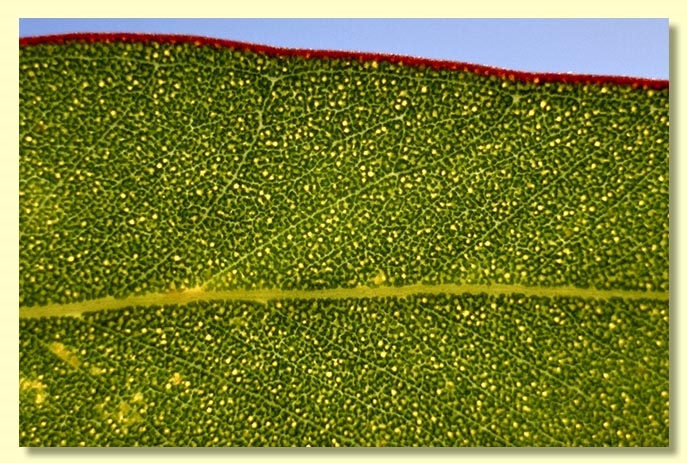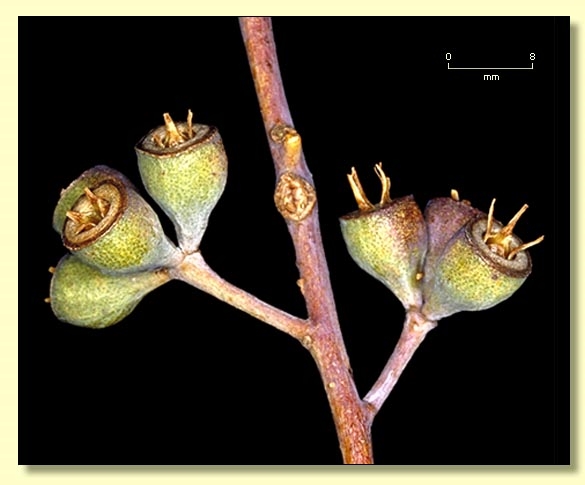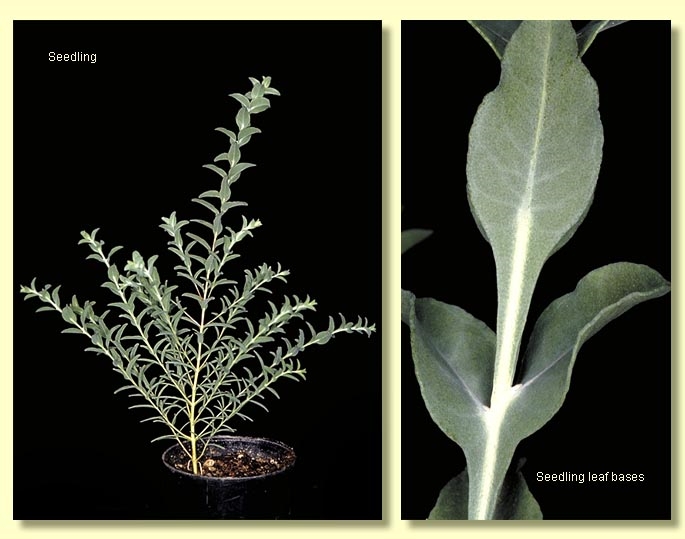Euclid - Online edition
Eucalyptus rhomboidea
Eucalyptus | Symphyomyrtus | Bisectae | Destitutae | Subulatae | Decurrentes
Bark smooth throughout, grey to creamy-grey to orange-brown, shedding in strips and short ribbons.
Branchlets glaucous; lacking oil glands in the pith.
Juvenile growth (coppice or field seedlings to 50 cm): stem square in cross-section, glaucous, juvenile leaves opposite, sessile, ovate to elliptical, not measured, glaucous, apex pointed, bases strongly decurrent on stem.
Adult leaves alternate, petiole (1.7)2–3(3.3) cm long; blade lanceolate, 8–15.5 cm long, 1.5–3.5 cm wide, base tapering to petiole, concolorous, dull, green to grey-green to blue-green, side-veins at an acute or wider angle to midrib, densely to very densely reticulate, intramarginal vein parallel to and just within margin, oil glands numerous and mostly intersectional.
Inflorescence axillary unbranched, peduncles 0.7–1.3 cm long, erect; buds usually 7, pedicellate (pedicels 0.1-0.4 cm long). Mature buds ± ovoid to rhomboid (c. 1.2 cm long, c. 0.6 cm wide), glaucous, scar present, operculum conical to slightly beaked (0.7–0.8 cm long), stamens irregularly flexed, anthers versatile, basifixed, globoid, dehiscing by slits, style long, stigma tapered, locules 3 or 4, the placentae each with 4 vertical ovule rows. Flowers pale yellow.
Fruit erect, fruit pedicellate (pedicels 0.1–0.4 cm long), cup-shaped to funnel-shaped, usually glaucous but glaucescence weathering with age, 0.7–0.8 cm long, 0.7–0.9 cm wide, disc level to slightly descending, valves 3 or 4, valve tips strongly exserted due to fragile style remnants.
Seeds brown to grey, 1.5–2 mm long, ovoid or flattened-ovoid, rarely pointed at one end, occasionally with shallow longitudinal furrows on otherwise smooth dorsal surface, hilum ventral.
Cultivated seedlings (measured at node 10): cotyledons Y-shaped (bisected); stems square in cross-section and prominently winged due to decurrent leaf bases, slightly glaucous; leaves opposite for many pairs (at least 20), sessile, linear to narrowly oblong for the first few nodes then becoming ovate, dull grey-green to slightly glaucous, 1.5–4 cm long, 0.5–3.2 cm wide, leaf base decurrent on stem.
Flowering has been recorded in September and October.
A small to medium-sized woodland tree endemic to Western Australia, restricted to areas of greenstone geology in the gently undulating Mt Glass–Mt Gordon area of the Bremer Range, ca midway between Lake King and Norseman. The bark is smooth throughout and the adult leaves are dull, light green to grey-green to blue-green, the buds glaucous and more or less rhomboid to ovoid in shape.
Eucalyptus rhomboidea belongs in Eucalyptus subgenus Symphyomyrtus section Bisectae subsection Destitutae because buds have two opercula, cotyledons are Y-shaped and branchlets lack oil glands in the pith. Within this subsection E. rhomboidea is part of a large taxonomic group (series Subulatae) further characterised by globoid basifixed anthers, grey smooth seeds with shallow longitudinal furrows dorsally, and fruit with semi-persistent exserted style remnants. Series Subulatae is divided principally into four subseries based on the juvenile leaves: one with spiral, crowded seedling phyllotaxis (subseries Spirales), another with decussate and strongly decurrent seedling leaves (subseries Decurrentes), another with decussate non-decurrent seedling leaves(subseries Decussatae), and a fourth with disjunct, petiolate seedling leaves (subseries Oleaginae).
Eucalyptus rhomboidea is part of subseries Decurrentes and is closely related to the smooth-barked tree species E. transcontinentalis which is widespread in the wheatbelt and goldfields of Western Australia. The latter species has pendulous buds with a relatively long, narrow, beaked operculum. This contrasts with the buds of E. rhomboidea which are held erect and are slightly broader, with a shorter, conical to slightly beaked operculum. The fruit shape of both species is also diagnostic, with those of E. transcontinentalis being urceolate to barrel-shaped and E. rhomboidea cup-shaped to funnel-shaped. Whilst both species occur in the same general area they do not grow together on the greenstone.













